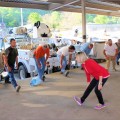Posted: Tuesday, September 20, 2016 11:17 am | Updated: 2:14 pm, Tue Sep 20, 2016.
About this time of year five years ago, I took a pretty bad fall and broke my shoulder in two places. You might recall that I was running with Mike, my hubby, out at the Weir Dam, on a beautiful fall Saturday morning. The leaves were beginning to shed off of the trees and there was just enough on the path that it was covering a big root protruding up from the ground. My toe caught the root just right and down I went. Let me pause here to tell you that when I fall, it is simply not pretty. I flail around like a fish on the end of a hook. It takes me several seconds to fall because I fight it so hard. Nevertheless, that day I fell and fell hard. I threw my left arm out (not supposed to do that) to protect my face, and well the rest is history.
A trip to the ER and 4 hours later it was confirmed that I had broken my humerus bone in two places and had a slap tear in my rotator cuff. Dr. Tagert kept telling me that if the bone shifted a millimeter I would have to have surgery. I held my breath every time he did an x-ray praying that surgery would not be necessary. Thankfully it was not, but the healing process, and the rehab process was long. I was chomping at the bit to get back into full workout mode, and somewhat back to normal. Many people told me that my shoulder would never be the same, it would always have a limited range of motion, with stiffness, and pain. I began what is called a restorative exercise program after physical therapy was completed. Typically a restorative exercise program helps an individual regain flexibility, strength, proprioception (The ability to sense stimuli arising within the body regarding the position, motion, and equilibrium) and endurance after an injury or post-surgery. This is an extremely important step after physical therapy rehabilitation is over to help an individual transition back to full function. So my work really began after my sessions with the physical therapist ended.
After an injury or post-surgery (after you have been released by your physician and therapist) there are things you must do to restore your body back to full function. Most individuals become tentative about movement and therefore never get full function back to the injured area. Decline in flexibility and strength of the injured area and compromised balance, is very common and should be fully addressed with restorative exercises. Restorative exercises programs can help with the following:
»Flexibility- Flexibility is defined as the range of motion (ROM) of a joint. Methods used to increase flexibility are static stretching (slow sustained stretches), Proprioceptive neuromuscular facilitation (often referred to as a contract/relax method of stretching) and myofascial release or manual massage technique typically performed with a foam roller.
»Strengthening of the post injury or post-surgery muscle, joint, and affected area, utilizing progressive restorative exercises will ensure adequate progression to full function. The key is to start slowly and progress to more challenging resistance as the area becomes stronger. Also, it may be necessary to modify certain exercises or eliminate them all together to protect against further injuries.
»Regain proprioception and balance- When an injury occurs, these pathways can be compromised due to trauma or disuse, which leads to poor balance and increase risk of injury.
Retraining these pathways is necessary to maintain neuromuscular control during functional activities.
If you have sustained an injury or you are post-surgery, your real work may begin after you have been dismissed from rehabilitation. To return to full function and prevent another injury it is wise to restore your body to full function with restorative exercises. Stability and mobility will be enhanced by this method.
Thankfully, my shoulder is very flexible, strong and is still serving me well.
See you in the gym!






